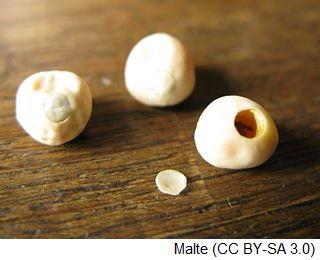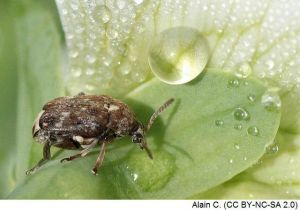Bruchus pisorum
1. General description
| Scientific name | Bruchus pisorum |
| Classification | Order Coleoptera, family Bruchidae |
| Geographical range | Frequently reported in the production regions of southern and western France, sporadically reported in Normandy and Champagne-Ardenne, newly reported in previously unaffected departments north of the Loire. |
| Crops affected | Winter and springpeas (strictly monophagous) |
2. Biology and epidemiology
Biological cycle
Conditions favourable to development
| Environment | / |
| Climate | Pea bruchids are active from 20°C and temperatures close to 25°C are very favourable. |
| Cultivation history of the plot | / |
| Plot environment | Bruchids overwinter as adults, but we do not know exactly where they overwinter. |
3. Damage
Symptoms and damage
The presence of bruchids in the plot can be identified by observing elongated (0.6 * 1.5 mm), creamy-white eggs on the pods.
Bruchids cause little yield loss but affect seed quality. The presence of liveinsects is prohibited in marketed batches. The holes formed in the seeds (see photo below, bruchid holes on peas) are barely tolerated in human food (threshold of 1 to 3%) and to a lesser extent in animal feed (threshold of 10%). The germination capacity of bruised seeds is also weakened, even if the germ is not affected, because damaged seeds are more susceptible to root diseases at the start of the cycle.

Measuring systems
Existing bruchid trapping systems are not very effective.
==== Bruch-LIS ==== is an agro-meteorological model that makes it possible to position insecticide treatments for pea bruchids as effectively as possible, depending on the crop's stage of development, weather conditions and product persistence.
Pest
(to be completed)
4. Management methods
Measures upstream of the crop
It is important to limit the population of breeding adults likely to re-infest crops the following year by taking action as soon as the crop is placed in the silo, as the peak of adult emergence (around 90%) occurs in the first 4 weeks following harvest (see Catch-up solutions).
Catch-up solutions
Rem : collective control is desirable within a production basin, as bruchids can fly far and wide.
| Type | Description | Effectiveness |
| Biological control | The bruchid has natural predators, including a micro wasp from the Braconidae family which lays eggs in the larvae developing in the seed. | Respecting these auxiliary insects does not prevent the larvae from penetrating the seeds, but it does help to prevent bruchid outbreaks in crops. |
| Chemical control | In crop production, insecticide control only targets the adults, as the larvae take shelter in the pods and then the seeds as soon as the eggs hatch. | The products available are only partially effective. As peas are a crop visited by pollinating insects, beware of bee legislation! |
| Chemical control | After harvest, application of deltamethrin (contact insecticide). | Nearly 100% control of adults emerging from the seeds, ineffective on larvae. |
| Chemical control | After harvest, phosphine fumigaton by an approved operator in a sealed silo. | 100% control of adults and larvae |
| Physical control | After harvesting, hot air drying (50-70°C depending on duration). | Good for adults and larvae. Drying too quickly or too hot may alter the colour of the seeds. |
| Physical control | After harvest, freeze batches. | Ineffective : bruchids survive at very low temperatures. |
| Physical control | After harvest, mechanical sorting of waste once the adult bruchids have emerged from the seeds. | Commonly used in organic farming, but requires a delay before marketing and does not eliminate the risk of bruchid dispersal in the environment. |
Innovative solutions
/
5. To find out more...
- e-phytia page : Pea leaf bruchid - 2017 - INRA http://ephytia.inra.fr/fr/C/11610/hypp-Bruchus-rufimanus
- Bruchid on peas - 2017 - Terres Inovia http://www.terresinovia.fr/pois/cultiver-du-pois/ravageurs/bruche/+
- What's new in protein crops? - 2012 - Arvalis, UNIP - Crop data sheets : winter peas and spring peas in the western region ; Pea and faba bean flea beetles : optimising control using observations and a decision-making tool.
- Integrated control of faba bean and pea bruchid - 2007 - L. Salles - ENITA de Clermont-Ferrand
Appendices
S'attaque aux cultures
